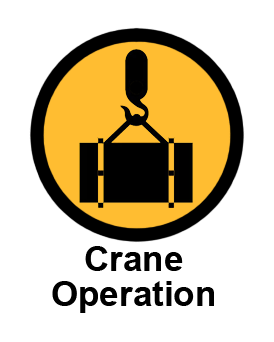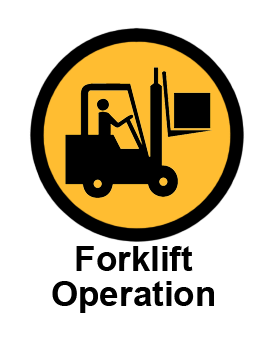Weight Handling - Safety
Weight Handling
Whenever cranes and/or other weight-handling equipment are operated, there is the potential for serious injury and property damage if the equipment is operated by untrained personnel or is not certified and maintained properly. Lifting loads improperly, attempting to hoist loads greater than the crane's rated capacity, maintaining cranes inadequately, or failing to load-test and certify cranes annually can cause catastrophic failure of the crane, resulting in personnel injury, loss of life, and/or serious property damage.
The proper licensing, operation, maintenance, and safe handling of weight-handling equipment is regulated by NPSINST 5100.11 (series), "Management of Weight Handling Equipment" with responsibilities delineated therein. All department chairs, WHE operators, the NPS Occupational Safety, Health, and Environmental (OSHE) Directorate, and NPS work centers affected by NPSINST 5100.11 will become familiar with the contents of NPSINST 5100.11 and ensure strict compliance.
Training
 |
The Navy Crane Center (NCC) developed a WHE category 3 crane operator safety course that is accessible at: https://learning.nel.navy.mil/ NCC-C3CS-04.3 Category 3 Non-Cab Operated Crane Safety The Navy Crane Center has created a General Crane Safety Web Based Training Student Guide that covers the requirements for Weight Handling Equipment in the NAVFAC P-307 including maintenance (repairs and alterations), inspection, test, certifcation, operations, training, licensing, and rigging gear use. |
 |
Anyone who operates a powered Industrial Trucks (Forklift) must recieve Formal Training on operation (ref 29 CFR 1910.178 (I)(2)(ii)).
If you require this training to perform your duties, then please contact the NPS Safety Office at safety@nps.edu.
Note- In addition to training, all forklift operators need to be enrolled in the medical surveillance program. |
Weight Handling Accidents and Near-Misses
In addition to the investigation and reporting requirements of OPNAV Instructions 5102.1 and 5100.23, activities shall investigate and report accidents in accordance with this section. There are two general categories of accidents as defined below. Crane accidents are those that occur during operation of a category 1, 2, 3, or 4 crane. Rigging gear accidents are those that occur when gear covered by section 14 is used by itself in weight handling operation, i.e., without category 1 through 4 cranes, or when covered gear is used with multi-purpose machines, material handling equipment, (e.g., forklifts) and with equipment covered by NAVFAC P-300 in a weight handling operation.
Crane Accident
A crane accident occurs when crane, operator, crane’s supporting structure, or lift procedure fails to perform correctly during operation, including operation during maintenance or testing resulting in the following:
1. Personnel injury or death. Minor injuries that are inherent in any industrial operation, including strains and repetitive motion related injuries, shall be reported by the normal personnel injury reporting process of the activity in lieu of these requirements.
2. Material or equipment damage.
3. Dropped load.
4. Derailment.
5. Two-blocking.
6. Overload. (This includes load tests when the test load tolerance is exceeded.)
A component failure (e.g., motor burnout, gear tooth failure, bearing failure) is not considered an accident solely due to material or equipment damage unless the component failure results in damage to other components (e.g., dropped boom, dropped load, roll over, etc.).
Rigging Gear Accident
A rigging gear accident occurs when the rigging gear, user of the gear, the gear’s supporting structure, rigging procedures fails to perform correctly during weight handling operations resulting in the following:
1. Personnel injury or death. Minor injuries that are inherent in any industrial operation, including strains and repetitive motion related injuries, shall be reported by the normal personnel injury reporting process of the activity in lieu of these requirements.
2. Material or equipment damage that requires the damaged item to be repaired because it can no longer perform its intended function. This does not include superficial damage such as scratched paint, damaged lagging, or normal wear on rigging gear.
3. Dropped load.
4. Two-blocking of cranes and powered hoists.
5. Overload. (This includes load tests when the test load tolerance is exceeded.)
How to Report Accidents
Upon having an accident or having seen evidence of damage (suspected accident), the crane team, riggers, equipment users, etc., shall stop all operations and notify immediate supervisor(s). If there is impending danger to the equipment or personnel, place the crane and/or load in a safe position prior to notifying supervision. Ensure the accident scene is secured and undisturbed so as to facilitate the investigation. The supervisor shall review the situation and take any further emergency action, including stopping production work or other operations that could aggravate the situation. The supervisor shall notify management personnel as well as the safety office.
Notify the Navy Crane Center (Code 07) by fax (757-967-3808), phone, or e-mail (nfsh_ncc_accident@navy.mil) as soon as practical but not later than 24 hours after an accident involving a fatality, in-patient hospitalization, overturned crane, collapsed boom, or any other major damage to the crane, load, or adjacent property. For all other accidents, notify the Navy Crane Center as soon as practical but
no later than three working days after the accident. If notification is by fax or e-mail, provide a point of contact for additional information.
CRANE AND RIGGING GEAR ACCIDENT REPORT FORM (NAVFAC PUB-307 Fig 12-1)
Near Misses and Other Unplanned Occurrences.
Near misses and other unplanned occurrences with lessons to be learned that do not fall under the crane and rigging gear accident definitions, shall be reported using the Near Miss Report form. E-mail the Naval Crane Center (noted above) within 30 days of the occurrence. A near miss is a situation where an accident was avoided by mere chance or where intervention prevented an ongoing sequence of events that would have resulted in an accident. It is not intended that the investigation and report be as thorough as that for a crane or rigging gear accident; however, the investigation and report should be commensurate with the significance of the event.
CRANE AND RIGGING GEAR NEAR-MISS REPORT FORM (NAVFAC PUB-307 Fig 12-2)
Resources
- NPSINST 5100.11 (series), "Management of Weight Handling Equipment"
- NAVFAC P-307, NAVFAC Management of Weight Handling Equipment and Maintenance Certification
- NSAMINST 11260.1, Weight Handling Equipment (WHE) Management and Qualification Program
- OSHA Safety and Health Standards 29 CFR 1910
- OSHA Safety and Health Standards 29 CFR 1926
- OPNAVINST 5100. 23G, Navy Safety and Occupational Health Program Manual
- SECNAVINST 11260.2 of 10 Sept 97, Navy Weight Handling Program for Shore Activities
- NAVFAC P-300, Management of Transportation Equipment
- CRANE AND RIGGING GEAR ACCIDENT REPORT FORM (NAVFAC PUB-307 Fig 12-1)
- CRANE AND RIGGING GEAR NEAR-MISS REPORT FORM (NAVFAC PUB-307 Fig 12-2)


